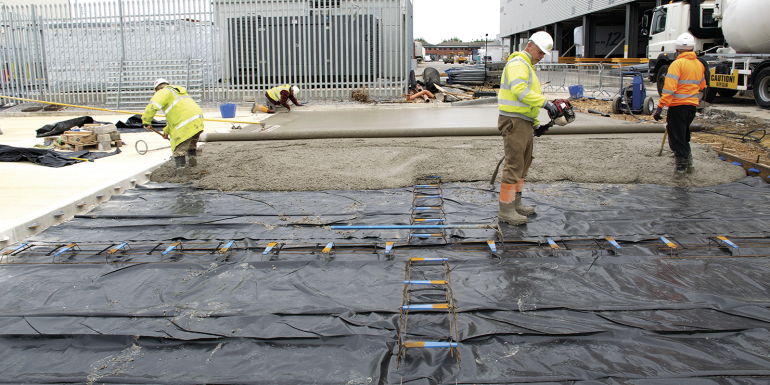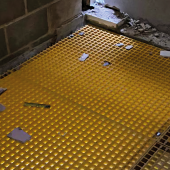No meshing

Danley case study shows how concrete can be used without the traditional mesh reinforcement by combining ground-supported flatwork with tapered plate dowels.
The concrete service yard at Next plc’s Distribution Centre in South Elmsall, West Yorkshire, has become the first UK project to utilise Danley’s Strategic Reinforcement™ Design. To enable delivery trucks to back up and offload goods into the warehouse, Adept Consulting Engineers was tasked with designing the structural works for the concrete pavement of the external service yard.
Martin Langan, Technical Consultant at Adept, says: “In the UK, mesh reinforcement is the most common method used to reinforce concrete service yard slabs. We have previously specified mesh and it is what groundworks contractors are used to installing. Therefore, when Danley first introduced us to [this] – a method that is widely used in North America – we were intrigued. Danley proposed that by removing the steel from the mid-panel and putting it at the joints, the strategic controlling of cracks can maintain the structural integrity of concrete slabs, and the use of tapered plate dowels allows for slab shrinkage and lateral movement.”
The method combines ground-supported flatwork designs with tapered plate dowels, which include PD3™ Dowel Cradles for sawn free-movement joints and Danley Dowels for construction joints. The long-term serviceability and durability of concrete ground-supported slabs is delivered through management of the natural behaviour of concrete. As most failures and deterioration of concrete slabs occur at the joints, Danley offers a joint design layout for the specific application, placing steel where it provides the most benefit, which is at the joints, for reliable load transfer. Therefore, all mid-panel reinforcement is eliminated. The result is long-term joint stability, with minimised joint spalling and reduced out-of-joint panel cracks.
“Our original specification detailed a 200mm C35A concrete slab with mesh throughout and joints spaced at 7m x 5m panels,” notes Langan. “At the contraction joints, H16mm diameter Dowel Bars at 300mm centres were going to be used. For the redesign of the joint layout using the Danley system, we worked closely with Danley’s Matt Bollé to ensure that the joint details were accurate on our drawings.”
Strategic Reinforcement™ Design often results in thinner concrete slabs. The design specified 165mm PAV2 concrete slabs, no mesh and joints spaced on a 4m x 4m grid. The smaller panels allow more controlled cracking of the concrete within the joints to relieve shrinkage stresses that develop during the curing process. 10mm thick Danley Dowels were used at the construction joints and 10mm thick PD3™ Dowel Cradles at the sawn contraction joints. The combined effect of smaller panels and the load transfer efficiency of the tapered plate dowels with free movement at the joints ensures that stresses within the concrete are minimised. In comparison with the original specification, this resulted in 17.5% less concrete by volume, contributing to reduced costs, improved concrete delivery logistics and the reduction of CO2 emissions.
Time savings
As part of the design, the PD3™ Dowel Cradles feature a tapered and sleeveless plate dowel that offers load transfer performance, thereby limiting joint deflection. For the design of service yards, Danley’s tapered plate dowels maintain joint deflection to less than 0.5mm. The 10mm tapered plate dowels alternate within the cradle to maximise the percentage of steel at the joint and provide generous installation tolerances. For simplified installation, the dowels are manufactured at preset heights and spacing, and can serve a range of slab thicknesses. Weighing less than 8kg, they are easy to carry and place, saving time and reducing workforce fatigue.
Paul Turner, Director at QED Construction, comments: “This method was very new to us. I have been in the trade for a long time, and this was the first time I had heard of it. The elimination of mesh meant that we required one less labourer and that we didn’t need to set up the day before. This also resulted in less steel to use and less load to carry. For every 120m²-150m², we saved around half a day’s work.” QED Construction realised an installed cost saving of 17%. The reduced slab thickness for this project resulted in eight fewer deliveries, and there was an 80% reduction in steel by weight, further reducing carbon emissions.
“[The dowels] eliminate the need for drilling or processing of the timber formwork that is required with traditional steel dowel bars, and the plastic sleeves made stripping off the formwork much easier, saving us a couple of hours each pour,” Turner comments. “We also found it easier to keep the dowels level upon installation. We now use [these] as standard across all of our current projects. For projects that we have tendered for, we have proposed [this] to the structural engineers.”
For the Next high bay extension, the implementation of the Strategic Reinforcement™ Design offers a long-life, hardstanding solution, and reduced maintenance and downtime costs over the lifetime of the facility.
For more, visit danley.co.uk
The Strategic Reinforcement™ Design complies with the Concrete Society’s TR66 Rev 1: External In-Situ Concrete Paving; ACI 330.2R-17: Guide for the Design and Construction of Concrete Site Paving for Industrial and Trucking Facilities; and ACI 360-R-10: Guide to Design of Slabs-on-Ground.








